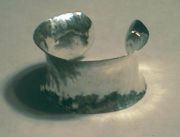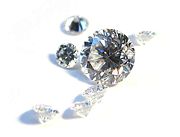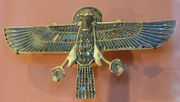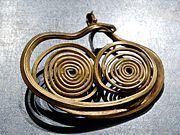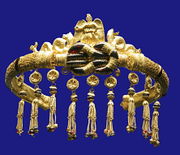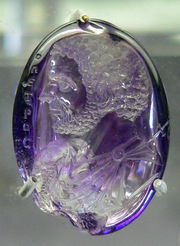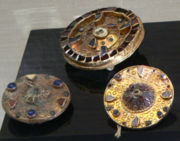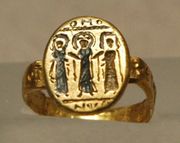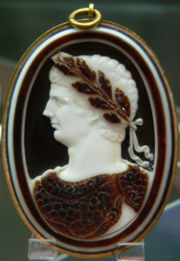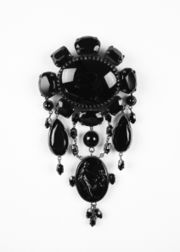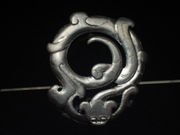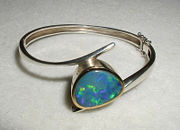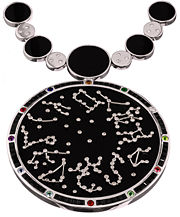Jewellery
2008/9 Schools Wikipedia Selection. Related subjects: Art
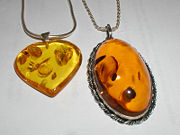
Jewellery (also spelled jewelry, see spelling differences) is a personal ornament, such as a necklace, ring, or bracelet, made from gemstones, precious metals or other materials.
The word jewellery is derived from the word jewel, which was anglicised from the Old French "jouel" around the 13th century. It has also been suggested that the word is deriverd from "Jew", as the Jews were important jewelry artisans of that time. Further tracing leads back to the Latin word "jocale", meaning plaything. Jewellery is one of the oldest forms of body adornment; recently found 100,000 year-old beads made from Nassarius shells are thought to be the oldest known jewellery.
Although during earlier times jewellery was created for practical uses such as wealth, storage and pinning clothes together, in recent times it has been used almost exclusively for decoration. The first pieces of jewellery were made from natural materials, such as bone, animal teeth, shell, wood, and carved stone. Jewellery was often made for people of high importance to show their status and, in many cases, they were buried with it.
Jewellery has been made to adorn nearly every body part, from hairpins to toe rings and many more types of jewellery. While high-quality is made with gemstones and precious metals, there is also a growing demand for Art jewelry where design and creativity is prized above material value. In addition, there is the less-costly costume jewellery, made from less-valuable materials and mass-produced. New variations include wire sculpture (wrap) jewellery, using anything from base metal wire with rock tumbled stone to precious metals and precious gemstones.
Form and function

Jewellery has been used for a number of reasons:
- Currency, wealth display and storage,
- Functional use (such as clasps, pins, and buckles)
- Symbolism (to show membership or status)
- Protection (in the form of amulets and magical wards),
- Artistic display
Most cultures have at some point had a practice of keeping large amounts of wealth stored in the form of jewellery. Numerous cultures move wedding dowries in the form of jewellery, or create jewellery as a means to store or display coins. Alternatively, jewellery has been used as a currency or trade good; an example being the use of slave beads.
Many items of jewellery, such as brooches and buckles originated as purely functional items, but evolved into decorative items as their functional requirement diminished.
Jewellery can also be symbolic of group membership, as in the case of the Christian crucifix or Jewish Star of David, or of status, as in the case of chains of office, or the Western practice of married people wearing a wedding ring.
Wearing of amulets and devotional medals to provide protection or ward off evil is common in some cultures; these may take the form of symbols (such as the ankh), stones, plants, animals, body parts (such as the Khamsa), or glyphs (such as stylized versions of the Throne Verse in Islamic art).
Although artistic display has clearly been a function of jewellery from the very beginning, the other roles described above tended to take primacy. It was only in the late 19th century, with the work of such masters as Peter Carl Fabergé and René Lalique, that art began to take primacy over function and wealth. This trend has continued into modern times, expanded upon by artists such as Robert Lee Morris and Ed Levin.
Materials and methods
In creating jewellery, gemstones, coins, or other precious items are often used, and they are typically set into precious metals. Alloys of nearly every metal known have been encountered in jewellery -- bronze, for example, was common in Roman times. Modern fine jewellery usually includes gold, white gold, platinum, palladium, or silver. Most American and European gold jewellery is made of an alloy of gold, the purity of which is stated in karats, indicated by a number followed by the letter K. American gold jewellery must be of at least 10K purity (41.7% pure gold), (though in England the number is 9K (37.5% pure gold) and is typically found up to 18K (75% pure gold). Higher purity levels are less common with alloys at 22 K (91.6% pure gold), and 24 K (99.9% pure gold) being considered too soft for jewellery use in America and Europe. These high purity alloys, however, are widely used across Asia, the Middle East, and Africa. Platinum alloys range from 900 (90% pure) to 950 (95.0% pure). The silver used in jewellery is usually sterling silver, or 92.5% fine silver. In costume jewelry, stainless steel findings are sometimes used.
Other commonly used materials include glass, such as fused-glass or enamel; wood, often carved or turned; shells and other natural animal substances such as bone and ivory; natural clay; polymer clay; and even plastics. Hemp and other twines have been used as well to create jewelry that has more of a natural feel. However, any inclusion of lead or lead solder will cause an English Assay office (the building which gives English jewellery its stamp of approval, the Hallmark) to destroy the piece.
Beads are frequently used in jewellery. These may be made of glass, gemstones, metal, wood, shells, clay and polymer clay. Beaded jewellery commonly encompasses necklaces, bracelets, earrings, belts, and rings. Beads may be large or small, the smallest type of beads used are known as seed beads, these are the beads used for the "woven" style of beaded jewellery. Another use of seed beads is an embroidery technique where seed beads are sewn onto fabric backings to create broad collar neck pieces and beaded bracelets. Bead embroidery, a popular type of handwork during the Victorian era is enjoying a renaissance in modern jewellery making. Beading, or beadwork, is also very popular in many African cultures.
Advanced glass and glass beadmaking techniques by Murano and Venetian glassmasters developed crystalline glass, enameled glass (smalto), glass with threads of gold (goldstone), multicoloured glass ( millefiori), milk-glass (lattimo) and imitation gemstones made of glass. As early as the 13th century, Murano glass and Murano beads were popular.
Silversmiths, goldsmiths, and lapidaries methods include forging, casting, soldering or welding, cutting, carving, and "cold-joining" (using adhesives, staples, and rivets to assemble parts).
Diamonds
Diamonds were first mined in India. Pliny may have mentioned them, although there is some debate as to the exact nature of the stone he referred to as Adamas; In 2005, Australia, Botswana, Russia and Canada ranked among the primary sources of gemstone diamond production.
The British crown jewels contain the Cullinan Diamond, part of the largest gem-quality rough diamond ever found (1905), at 3,106.75 carats (621.35 g).
Now popular in engagement rings, this usage dates back to the marriage of Maximilian I to Mary of Burgundy in 1477.
Other gemstones
Many precious stones are used for jewellery. Some gems, for example, amethyst, have become less valued as methods of extracting and importing them have progressed. Some man-made gems can serve in place of natural gems, an example is the cubic zirconia, used in place of the diamond.
Metal finishes
For platinum, gold, and silver jewellery there are many techniques to create finishes. The most common are high-polish, satin/matte, brushed, and hammered. High-polished jewellery is by far the most common and gives the metal the highly-reflective and shiny look. Satin, or matte finish reduces the shine and reflection of the jewellery and is commonly used to accentuate gemstones such as diamonds. Brushed finishes give the jewellery a textured look, and are created by brushing a material (similar to sandpaper) against the metal, leaving 'brush strokes'. Hammered finishes are typically created by using a soft, rounded hammer and hammering the jewellery to give it a wavy texture.
Impact on society
Jewellery has been used to denote status. In ancient Rome, for instance, only certain ranks could wear rings; Later, sumptuary laws dictated who could wear what type of jewellery; again based on rank. Cultural dictates have also played a significant role; for example, the wearing of earrings by Western men was considered "effeminate" in the 19th and early 20th centuries. More recently, the display of body jewellery, such as piercings, has become a mark of acceptance or seen as a badge of courage within some groups, but is completely rejected in others. Likewise, the hip-hop culture has popularized the slang term bling, which refers to ostentatious display of jewellery by men or women.
Conversely, the jewellery industry in the early 20th century launched a campaign to popularize wedding rings for men — which caught on — as well as engagement rings for men - which did not, going so far as to create a false history and claim that the practice had Medieval roots. By the mid 1940s, 85% of weddings in the U.S. featured a double-ring ceremony, up from 15% in the 1920s. Religion has also played a role: Islam, for instance, considers the wearing of gold by men as a social taboo, and many religions have edicts against excessive display.
History
The history of jewellery is a long one, with many different uses among different cultures. It has endured for thousands of years and has provided various insights into how ancient cultures worked.
Early history
The first signs of jewellery came from the Cro-Magnons, ancestors of Homo sapiens, around 40,000 years ago. The Cro-Magnons originally migrated from the Middle East to settle in Europe and replace the Neanderthals as the dominant species. The jewellery pieces they made were crude necklaces and bracelets of bone, teeth and stone hung on pieces of string or animal sinew, or pieces of carved bone used to secure clothing together. In some cases, jewellery had shell or mother-of-pearl pieces. In southern Russia, carved bracelets made of mammoth tusk have been found. Most commonly, these have been found as grave-goods. Around 7,000 years ago, the first sign of copper jewellery was seen.
Egypt
The first signs of established jewellery making in Ancient Egypt was around 3,000-5,000 years ago. The Egyptians preferred the luxury, rarity, and workability of gold over other metals. Predynastic Egypt had Jewellery in Egypt soon began to symbolize power and religious power in the community. Although it was worn by wealthy Egyptians in life, it was also worn by them in death, with jewellery commonly placed among grave goods.
In conjunction with gold jewellery, Egyptians used coloured glass in place of precious gems. Although the Egyptians had access to gemstones, they preferred the colours they could create in glass over the natural colours of stones. For nearly each gemstone, there was a glass formulation used by the Egyptians to mimic it. The colour of the jewellery was very important, as different colours meant different things; the Book of the Dead dictated that the necklace of Isis around a mummy’s neck must be red to satisfy Isis’s need for blood, while green jewellery meant new growth for crops and fertility. Although lapis lazuli and silver had to be imported from beyond the country’s borders, most other materials for jewellery were found in or near Egypt, for example in the Red Sea, where the Egyptians mined Cleopatra's favourite gem, the emerald. Egyptian jewellery was predominantly made in large workshops attached to temples or palaces.
Egyptian designs were most common in Phoenician jewellery. Also, ancient Turkish designs found in Persian jewellery suggest that trade between the Middle East and Europe was not uncommon. Women wore elaborate gold and silver pieces that were used in ceremonies.
Europe and the Middle East
Mesopotamia
By approximately 4,000 years ago, jewellery-making had become a significant craft in the cities of Sumer and Akkad. The most significant archaeological evidence comes from the Royal Cemetery of Ur, where hundreds of burials dating 2900–2300 BC were unearthed; tombs such as that of Puabi contained a multitude of artefacts in gold, silver, and semi-precious stones, such as lapis lazuli crowns embellished with gold figurines, close-fitting collar necklaces, and jewel-headed pins. In Assyria, men and women both wore extensive amounts of jewellery, including amulets, ankle bracelets, heavy multi-strand necklaces, and cylinder seals.
Jewellery in Mesopotamia tended to be manufactured from thin metal leaf and was set with large numbers of brightly-coloured stones (chiefly agate, lapis, carnelian, and jasper). Favoured shapes included leaves, spirals, cones, and bunches of grapes. Jewellers created works both for human use and for adorning statues and idols; they employed a wide variety of sophisticated metalworking techniques, such as cloisonne, engraving, fine granulation, and filigree.
Extensive and meticulously maintained records pertaining to the trade and manufacture of jewellery have also been unearthed throughout Mesopotamian archaeological sites. One record in the Mari royal archives, for example, gives the composition of various items of jewellery:
| “ | 1 necklace of flat speckled chalcedony beads including: 34 flat speckled chalcedony bead, [and] 35 gold fluted beads, in groups of five. 1 necklace of flat speckled chalcedony beads including: 39 flat speckled chalcedony beads, [with] 41 fluted beads in a group that make up the hanging device. 1 necklace with rounded lapis lazuli beads including: 28 rounded lapis lazuli beads, [and] 29 fluted beads for its clasp. |
” |
Greece
The Greeks started using gold and gems in jewellery in 1,400 BC, although beads shaped as shells and animals were produced widely in earlier times. By 300 BC, the Greeks had mastered making coloured jewellery and using amethysts, pearl and emeralds. Also, the first signs of cameos appeared, with the Greeks creating them from Indian Sardonyx, a striped brown pink and cream agate stone. Greek jewellery was often simpler than in other cultures, with simple designs and workmanship. However, as time progressed the designs grew in complexity different materials were soon utilized.
Jewellery in Greece was hardly worn and was mostly used for public appearances or on special occasions. It was frequently given as a gift and was predominantly worn by women to show their wealth, social status and beauty. The jewellery was often supposed to give the wearer protection from the “ Evil Eye” or endowed the owner with supernatural powers, while others had a religious symbolism. Older pieces of jewellery that have been found were dedicated to the Gods. The largest production of jewellery in these times came from Northern Greece and Macedon. However, although much of the jewellery in Greece was made of gold and silver with ivory and gems, bronze and clay copies were made also.
They worked two styles of pieces; cast pieces and pieces hammered out of sheet metal. Fewer pieces of cast jewellery have been recovered; it was made by casting the metal onto two stone or clay moulds. Then the two halves were joined together and wax and then molten metal, was placed in the centre. This technique had been practised since the late Bronze Age. The more common form of jewellery was the hammered sheet type. Sheets of metal would be hammered to thickness and then soldered together. The inside of the two sheets would be filled with wax or another liquid to preserve the metal work. Different techniques, such as using a stamp or engraving, were then used to create motifs on the jewellery. Jewels may then be added to hollows or glass poured into special cavities on the surface. The Greeks took much of their designs from outer origins, such as Asia when Alexander the Great conquered part of it. In earlier designs, other European influences can also be detected. When Roman rule came to Greece, no change in jewellery designs was detected. However, by 27 BC, Greek designs were heavily influenced by the Roman culture. That is not to say that indigenous design did not thrive; numerous polychrome butterfly pendants on silver foxtail chains, dating from the 1st century, have been found near Olbia, with only one example ever found anywhere else.
Rome
Although jewellery work was abundantly diverse in earlier times, especially among the barbarian tribes such as the Celts, when the Romans conquered most of Europe, jewellery was changed as smaller factions developed the Roman designs. The most common artefact of early Rome was the brooch, which was used to secure clothing together. The Romans used a diverse range of materials for their jewellery from their extensive resources across the continent. Although they used gold, they sometimes used bronze or bone and in earlier times, glass beads & pearl. As early as 2,000 years ago, they imported Sri Lankan sapphires and Indian diamonds and used emeralds and amber in their jewellery. In Roman-ruled England, fossilized wood called jet from Northern England was often carved into pieces of jewellery. The early Italians worked in crude gold and created clasps, necklaces, earrings and bracelets. They also produced larger pendants which could be filled with perfume.
Like the Greeks, often the purpose of Roman jewellery was to ward off the “Evil Eye” given by other people. Although woman wore a vast array of jewellery, men often only wore a finger ring. Although they were expected to wear at least one ring, some Roman men wore a ring on every finger, while others wore none. Roman men and women wore rings with a carved stone on it that was used with wax to seal documents, an act that continued into medieval times when kings and noblemen used the same method. After the fall of the Roman Empire, the jewellery designs were absorbed by neighbouring countries and tribes.
Middle Ages

Post-Roman Europe continued to develop jewellery making skills; the Celts and Merovingians in particular are noted for their jewellery, which in terms of quality matched or exceeded that of Byzantium. Clothing fasteners, amulets, and to a lesser extent signet rings are the most common artefacts known to us; a particularly striking celtic example is the Tara Brooch. The Torc was common throughout Europe as a symbol of status and power. By the 8th century, jewelled weaponry was common for men, while other jewellery (with the exception of signet rings) seems to become the domain of women. Grave goods found in a 6th-7th century burial near Chalon-sur-Saône are illustrative; the young girl was buried with: 2 silver fibulae, a necklace (with coins), bracelet, gold earings, a pair of hair-pins, comb, and buckle. The Celts specialized in continuous patterns and designs; while Merovingian designs are best known for stylized animal figures. They were not the only groups known for high quality work; note the Visigoth work shown here, and the numerous decorative objects found at the Anglo-Saxon Ship burial at Sutton Hoo Suffolk, England, are a particularly well-known example. On the continent, cloisonné and garnet were perhaps the quintessential method and gemstone of the period.
The Eastern successor of the Roman Empire, the Byzantine Empire, continued many of the methods of the Romans, though religious themes came to predominate. Unlike the Romans, the Franks, and the Celts, however; Byzantium used light-weight gold leaf rather than solid gold, and more emphasis was placed on stones and gems. As in the West, Byzantine jewellery was worn by wealthier females, with male jewellery apparently restricted to signet rings. Like other contemporary cultures, jewellery was commonly buried with its owner.
Renaissance
The Renaissance and exploration both had significant impacts on the development of jewellery in Europe. By the 17th century, increasing exploration and trade lead to increased availability of a wide variety of gemstones as well as exposure to the art of other cultures. Whereas prior to this the working of gold and precious metal had been at the forefront of jewellery, this period saw increasing dominance of gemstones and their settings. A fascinating example of this is the Cheapside Hoard, the stock of a jeweller hidden in London England during the Commonwealth period and not found again until 1912. It contained Colombian emerald, topaz, amazonite from Brazil, spinel, iolite, and chrysoberyl from Sri Lanka, ruby from India, Afghani lapis lazuli, Persian turquoise, Red Sea peridot, as well as Bohemian and Hungarian opal, garnet, and amethyst. Large stones were frequently set in box-bezels on enamelled rings. Notable among merchants of the period was Jean-Baptiste Tavernier, who in the 1660s brought the precursor stone of the Hope Diamond to France.
When Napoleon Bonaparte was crowned as Emperor of the French in 1804, he revived the style and grandeur of jewellery and fashion in France. Under Napoleon’s rule, jewellers introduced parures, suites of matching jewellery, such as a diamond tiara, diamond earrings, diamond rings, a diamond brooch and a diamond necklace. Both of Napoleon’s wives had beautiful sets such as these and wore them regularly. Another fashion trend resurrected by Napoleon was the cameo. Soon after his cameo decorated crown was seen, cameos were highly sought after. The period also saw the early stages of costume jewellery, with fish scale covered glass beads in place of pearls or conch shell cameos instead of stone cameos. New terms were coined to differentiate the arts: jewellers who worked in cheaper materials were called bijoutiers, while jewellers who worked with expensive materials were called joailliers; a practice which continues to this day.
Romanticism
Starting in the late 18th century, Romanticism had a profound impact on the development of western jewellery. Perhaps the most significant influences were the public’s fascination with the treasures being discovered through the birth of modern archaeology, and the fascination with Medieval and Renaissance art. Changing social conditions and the onset of the industrial revolution also lead to growth of a middle class that wanted and could afford jewellery. As a result, the use of industrial processes, cheaper alloys, and stone substitutes, lead to the development of paste or costume jewellery. Distinguished goldsmiths continued to flourish, however, as wealthier patrons sought to ensure that what they wore still stood apart from the jewellery of the masses, not only through use of precious metals and stones but also though superior artistic and technical work; one such artist was the French goldsmith Françoise Désire Fromment Meurice. A category unique to this period and quite appropriate to the philosophy of romanticism was mourning jewellery. It originated in England, where Queen Victoria was often seen wearing jet jewellery after the death of Prince Albert; and allowed the wearer to continue wearing jewellery while expressing a state of mourning at the death of a loved one.
In the United states, this period saw the founding in 1837 of Tiffany & Co. by Charles Lewis Tiffany. Tiffany's put the United States on the world map in terms of jewellery, and gained fame creating dazzling commissions for people such as the wife of Abraham Lincoln; later it would gain popular notoriety as the setting of the film Breakfast at Tiffany's. In France, Pierre Cartier founded Cartier SA in 1847, while 1884 saw the founding of Bulgari in Italy. The modern production studio had been born; a step away from the former dominance of individual craftsmen and patronage.
This period also saw the first major collaboration between East and West; collaboration in Pforzheim between German and Japanese artists lead to Shakudo plaques set into Filigree frames being created by the Stoeffler firm in 1885). Perhaps the grand finalé – and an appropriate transition to the following period – were the masterful creations of the Russian artist Peter Carl Fabergé, working for the Imperial Russian court, whose Fabergé eggs and jewellery pieces are still considered as the epitome of the goldsmith’s art.
Art Nouveau
In the 1890s, jewellers began to explore the potential of the growing Art Nouveau style. Very closely related were the German Jugendstil, British (and to some extent American) Arts and Crafts movement. Art Nouveau jewellery encompassed many distinct features including a focus on the female form and an emphasis on colour, most commonly rendered through the use of enamelling techniques including basse-taille, champleve, cloisonné and plique a jour. Motifs included orchids, irises, pansies, vines, swans, peacocks, snakes, dragonflies, mythological creatures and the female silhouette. Rene Lalique, working for the Paris shop of Samuel Bing, was recognized by contemporaries as a leading figure in this trend. The Darmstadt Artists' Colony and Wiener Werkstaette provided perhaps the most significant German input to the trend, while in Denmark Georg Jensen, though best known for his Silverware, also contributed significant pieces. In England, Liberty & Co and the British arts & crafts movement of Charles Robert Ashbee contributed slightly more linear but still characteristic designs. The new style moved the focus of the jeweller's art from the setting of stones to the artistic design of the piece itself; Lalique's dragonfly design is one of the best examples of this. Enamels played a large role in technique, while sinuous organic lines are the most recognizable design feature. The end of World War One once again changed public attitudes; and a more sober style came in.
Art Deco
Growing political tensions, the after-effects of the war, and a reaction against the perceived decadence of the turn of the century led to simpler forms, combined with more effective manufacturing for mass production of high-quality jewellery. Covering the period of the 1920s and 1930s, the style has become popularly known as Art Deco. Walter Gropius and the German Bauhaus movement, with their philosophy of "no barriers between artists and craftsmen" lead to some interesting and stylistically simplified forms. Modern materials were also introduced: plastics and aluminium were first used in jewellery, and of note are the chromed pendants of Russian born Bauhaus master Naum Slutzky. Technical mastery became as valued as the material itself; in the west, this period saw the reinvention of granulation by the German Elizabeth Treskow (although development of the re-invention has continued into the 1990s).
Jewish jewellery
In the Jewish culture jewellery have played an important role since biblical times. There are references in the bible to the custom of wearing jewellery both as a decoration and as a symbol. Now, Jewish jewellery is worn to show affiliation with the religion, and as talismans and amulets.
The Star of David ("Magen David" in Hebrew) is the symbol most recognized with Judaism. It was used in Israel in Roman times, but it seems to have become associated with Judaism in particular only in later centuries. In the 17th century it became a practice to put the Star of David on the outside of synagogues, to identify them as Jewish houses of worship; however, it is not clear why this symbol was selected for this. Today the Star of David is a universally recognized symbol of Jews. It appears on the flag of the state of Israel, and the Israeli equivalent of the Red Cross is known as "the Magen David Adom" ("Adom" is red in Hebrew). One of the most common symbols in Jewish jewellery is the Star of David, equivalent to wearing a cross by Christians.
Another popular symbol used in Jewish jewellery is the Hamsa, also known as the "Hamesh hand". The Hamsa appears often in a stylized form, as a hand with three fingers raised, and sometimes with two thumbs arranged symmetrically. Its five fingers are said to symbolize the five books if the Torah. The symbol is used for protection and as a mean to ward of the Evil eye in amulets and charms and can also be found in various places such as home entrances and cars. It is also common to place other symbols in the middle of the Hamsa that are believed to help against the evil eye such as fish, eyes and the Star of David. The colour blue, or more specifically light blue, is also considered protective against the evil eye and many Hamsas are in that colour or with embedded gemstones in different shades of blue. Hamsas are often decorated with Jewish prayers of a protective fashion such as the Sh'ma Prayer, the Birkat HaBayit (Blessing for the Home), or the Tefilat HaDerech (Traveler's Prayer).
The Chai symbol, popularly worn on necklaces, is the Hebrew word "Chai" (means 'living'), consisting of the two Hebrew letters Chet and Yod. This word refers to God. According to the gematrian system, the letters of Chai add up to 18. There have been many mystical numerological speculations about this fact and the custom to give donations and monetary gifts in multiples of 18 as a blessing for long life is very common in Jewish circles.
Other motives found in Jewish jewellery are symbols from the Kabbalah (also known as kabala, cabala) such as the Merkaba, a three-dimensional Star of David, and the Tree of life. Pieces of jewellery are decorated with parts or initials of known Jewish prayers and with 3-letters combinations, believed to represent different names of the Jewish God.
Asia
Jewellery making in Asia started in China 5,000 years ago and in the Indus Valley region later on.
China
The earliest culture to begin making jewellery in Asia was the Chinese around 5,000 years ago. Chinese jewellery designs were very religion-orientated and contained Buddhist symbols, a fact which remains to this day.
The Chinese used silver in their jewellery more often than gold, and decorated it with their favourite colour, blue. Blue kingfisher feathers were tied onto early Chinese jewellery and later, blue gems and glass were incorporated into designs. However, Chinese preferred jade over any other stone. They fashioned it using diamonds. The Chinese revered jade because of the human-like qualities they assigned to it, such as its hardness, durability and beauty. The first jade pieces were very simple, but as time progressed, more complex designs evolved. Jade rings from between the 4th and 7th centuries BCE show evidence of having been worked with a compound milling machine; hundreds of years before the first mention of such equipment in the west.
In China, jewellery was worn frequently by both sexes to show their nobility and wealth. However, in later years, it was used to accentuate beauty. Women wore highly detailed gold and silver head dresses and other items, while men wore decorative hat buttons which showed rank and gold or silver rings. Woman also wore strips of gold on their foreheads, much like women in the Indus Valley. The band was an early form of tiara and was often decorated with precious gems. The most common piece of jewellery worn by Chinese was the earring, which was worn by both men and women. Amulets were also common too, often with a Chinese symbol or dragon. In fact, dragons, Chinese symbols and also phoenixes were frequently depicted on jewellery designs.
The Chinese often placed their jewellery in their graves; most Chinese graves found by archaeologists contain decorative jewellery.
India
The Indian subcontinent has the longest continuous legacy of jewellery making anywhere. While Western traditions were heavily influenced by waxing and waning empires, India enjoyed a continuous development of art forms for some 5000 years. One of the first to start jewellery making were the peoples of the Indus Valley Civilization. By 1,500 BC the peoples of the Indus Valley were creating gold earrings and necklaces, bead necklaces and metallic bangles. Before 2,100 BC, prior to the period when metals were widely used, the largest jewellery trade in the Indus Valley region was the bead trade. Beads in the Indus Valley were made using simple techniques. First, a bead maker would need a rough stone, which would be bought from an eastern stone trader. The stone would then be placed into a hot oven where it would be heated until it turned deep red, a colour highly prized by people of the Indus Valley. The red stone would then be chipped to the right size and a hole drilled through it with primitive drills. The beads were then polished. Some beads were also painted with designs. This art form was often passed down through family; children of bead makers often learnt how to work beads from a young age.
Jewellery in the Indus Valley was worn predominantly by females, who wore numerous clay or shell bracelets on their wrists. They were often shaped like doughnuts and painted black. Over time, clay bangles were discarded for more durable ones. In India today, bangles are made out of metal or glass. Other pieces that women frequently wore were thin bands of gold that would be worn on the forehead, earrings, primitive brooches, chokers and gold rings. Although women wore jewellery the most, some men in the Indus Valley wore beads. Small beads were often crafted to be placed in men and women’s hair. The beads were about one millimetre long.
A female skeleton (presently on display at the National Museum, New Delhi, India) wears a carlinean bangle ( a bracelet) on her left hand.
India was the first country to mine diamonds, with some mines dating back to 296 BC. However, axes dating to 4,000 BC found in China, contain traces of diamond dust used to sharpen the blades. While China used the diamonds they found mainly for carving jade, India traded the diamonds, realising their valuable qualities. This trade almost vanished 1,000 years after Christianity grew as a religion, as Christians rejected the diamonds which were used in Indian religious amulets. Along with Arabians from the Middle East restricting the trade, India’s diamond jewellery trade lulled.
Today, many of the jewellery designs and traditions are still used and jewellery is commonplace in Indian ceremonies and weddings.
Americas
Jewellery played a major role in the fate of the Americas when the Spanish established an empire to seize South American gold. Jewellery making developed in the Americas 5,000 years ago in Central and South America. Large amounts of gold was easily accessible, and the Aztecs and Mayans created numerous works in the metal. Among the Aztecs, only nobility wore gold jewellery, as it showed their rank, power and wealth. Gold jewellery was most common in the Aztec Empire and was often decorated with feathers from birds. The main purpose of Aztec jewellery was to draw attention, with richer and more powerful Aztecs wearing brighter, more expensive jewellery and clothes. Although gold was the most common and popular material used in Aztec jewellery, silver was also readily available throughout the American empires. In addition to adornment and status, the Aztecs also used jewellery in sacrifices to appease the gods. Priests also used gem encrusted daggers to perform animal and human sacrifices.
Another ancient American civilization with expertise in jewellery making was the Maya. At the peak of their civilization, the Maya were making jewellery from jade, gold, silver, bronze and copper. Maya designs were similar to those of the Aztecs, with lavish head dresses and jewellery. The Maya also traded in precious gems. However, in earlier times, the Maya had little access to metal, so made the majority of their jewellery out of bone or stone. Merchants and nobility were the only few that wore expensive jewellery in the Maya Empire, much the same as with the Aztecs.
In North America, Native Americans used shells, wood, turquoise, and soapstone, almost unavailable in South and Central America. The turquoise was used in necklaces and to be placed in earrings. Native Americans with access to oyster shells, often located in only one location in America, traded the shells with other tribes, showing the great importance of the body adornment trade in Northern America.
Pacific
Jewellery making in the Pacific started later than in other areas because of recent human settlement. Early Pacific jewellery was made of bone, wood and other natural materials, and thus has not survived. Most Pacific jewellery is worn above the waist, with headdresses, necklaces, hair pins and arm and waist belts being the most common pieces.
Jewellery in the Pacific, with the exception of Australia, is worn to be a symbol of either fertility or power. Elaborate headdresses are worn by many Pacific cultures and some, such as the inhabitants of Papua New Guinea, wear certain headresses once they have killed an enemy. Tribesman may wear boar bones through their noses.
Island jewellery is still very much primal because of the lack of communication with outside cultures; some areas of Borneo and Papua New Guinea are yet to be explored by Western nations. However, the island nations which were flooded with Western missionaries have had drastic changes made to their jewellery designs. Missionaries saw any type of tribal jewellery as a sign of the wearer's devotion to paganism. Thus many tribal designs were lost forever in the mass conversion to Christianity.
Australia is now the number one supplier of opals in the world. Opals had already been mined in Europe and South America for many years prior, but in the late 1800s, the Australian opal market became predominant. Australian opals are only mined in a few select places around the country, making it one the most profitable stones in the Pacific.
One of the few cultures to today still create their jewellery as they did many centuries prior is the New Zealand Māori, who create Hei-tiki. The reason the hei-tiki is worn is not apparent; it may either relate to ancestral connections, as Tiki was the first Māori, or fertility, as there is a strong connection between this and Tiki. Another suggestion from historians is that the Tiki is a product of the ancient belief of a god named Tiki, perhaps dating back to before the Māoris settled in New Zealand. Hei-tikis are traditionally carved by hand from bone (commonly whale), nephrite or bowenite; a lengthy and spiritual process. The Hei-tiki is now popular amongst tourists who can buy it from souvenir or jeweller shops.
Other than jewellery created through Māori influence, jewellery in New Zealand remains similar to other western civilizations; multi cultural and varied. This is more noticeable in New Zealand because of its high levels of non-European citizens.
Modern
The modern jewellery movement began in the late 1940s at the end of World War II with a renewed interest in artistic and leisurely pursuits. The movement is most noted with works by Georg Jensen and other jewellery designers who advanced the concept of wearable art. The advent of new materials, such as plastics, Precious Metal Clay (PMC) and colouring techniques, has led to increased variety in styles. Other advances, such as the development of improved pearl harvesting by people such as Kokichi Mikimoto and the development of improved quality artificial gemstones such as moissanite (a diamond simulant), has placed jewellery within the economic grasp of a much larger segment of the population.
The "jewellery as art" movement was spearheaded by artisans such as Robert Lee Morris and continued by designers such as Anoush Waddington in the UK. Influence from other cultural forms is also evident; one example of this is bling-bling style jewellery, popularized by hip-hop and rap artists in the early 21st century.
The late 20th century saw the blending of European design with oriental techniques such as Mokume-gane. The following are innovations in the decades stradling the year 2000: "Mokume-gane, hydraulic die forming, anti-clastic raising, fold-forming, reactive metal anodizing, shell forms, PMC, photoetching, and [use of] CAD/CAM."
Artisan jewellery continues to grow as both a hobby and a profession. With more than 17 United States periodicals about beading alone, resources, accessibility and a low initial cost of entry continues to expand production of hand-made adornments. Some fine examples of artisan jewellery can be seen at The Metropolitan Museum.
Body modification
Jewellery used in body modification is usually plain; the use of simple silver studs, rings and earrings predominates. Common jewellery pieces such as earrings, are themselves a form of body modification, as they are accommodated by creating a small hole in the ear.
Padaung women in Myanmar place large golden rings around their necks. From as early as 5 years old, girls are introduced to their first neck ring. Over the years, more rings are added. In addition to the twenty-plus pounds of rings on her neck, a woman will also wear just as many rings on her calves too. At their extent, some necks modified like this can reach 10-15 inches long; the practice has obvious health impacts, however, and has in recent years declined from cultural norm to tourist curiosity. Tribes related to the Paduang, as well as other cultures throughout the world, use jewellery to stretch their earlobes, or enlarge ear piercings. In the Americas, labrets have been worn since before first contact by Innu and first nations peoples of the northwest coast. Lip plates are worn by the African Mursi and Sara people, as well as some South American peoples.
In the late 20th century, the influence of modern primitivism led to many of these practices being incorporated into western subcultures. Many of these practices rely on a combination of body modification and decorative objects; thus keeping the distinction between these two types of decoration blurred.
In many cultures, jewellery is used as a temporary body modifier, with in some cases, hooks or even objects as large as bike bars being placed into the recipient's skin. Although this procedure is often carried out by tribal or semi-tribal groups, often acting under a trance during religious ceremonies, this practise has seeped into western culture. Many extreme-jewellery shops now cater to people wanting large hooks or spikes set into their skin. Most often, these hooks are used in conjunction with pulleys to hoist the recipient into the air. This practise is said to give an erotic feeling to the person and some couples have even performed their marriage ceremony whist being suspended by hooks.
Jewellery Market
According to a recent KPMG study the largest jewellery market is the United States with a market share of 30.8%, Japan, India and China and the Middle East each with 8 - 9% and finally Italy with 5%. The authors of the study predict a dramatic change in market shares by 2015, where the market share of the United States will have dropped to around 25%, and China and India will increase theirs to over 13%. The Middle East will remain more or less constant at 9%, whereas Europe's and Japan's marketshare will be halved and become less than 4% for Japan, and less than 3% for the biggest individual European countries: Italy and the UK.
